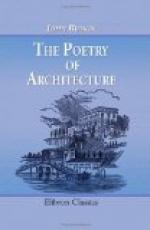[Footnote 6: Compare Modern Painters, vol. iv. chap. xi, and vol. v. chap. ix.]
44. Again, when a number of these cottages are grouped together, they break upon each other’s formality, and form a mass of fantastic proportion, of carved window and overhanging roof, full of character and picturesque in the extreme. An excellent example of this is the Bernese village of Unterseen. Again, when the ornament is not very elaborate, yet enough to preserve the character, and the cottage is old, and not very well kept (suppose in a Catholic canton), and a little rotten, the effect is beautiful: the timber becomes weather-stained, and of a fine warm brown, harmonizing delightfully with the gray stones on the roof, and the dark green of surrounding pines. If it be fortunate enough to be situated in some quiet glen, out of sight of the gigantic features of the scene, and surrounded with cliffs to which it bears some proportion; and if it be partially concealed, not intruding on the eye, but well united with everything around, it becomes altogether perfect; humble, beautiful, and interesting. Perhaps no cottage can then be found to equal it; and none can be more finished in effect, graceful in detail, and characteristic as a whole.
45. The ornaments employed in the decoration of the Swiss cottage do not demand much attention; they are usually formed in a most simple manner, by thin laths, which are carved into any fanciful form, or in which rows of holes are cut, generally diamond shaped; and they are then nailed one above another to give the carving depth. Pinnacles are never raised on the roof, though carved spikes are occasionally suspended from it at the angles. No ornamental work is ever employed to disguise the beams of the projecting part of the roof, nor does any run along its edges. The galleries, in the canton of Uri, are occasionally supported on arched beams, as shown in Fig. 4, which have a very pleasing effect.
[Illustration: Swiss Chalet Balcony, 1842.]
46. Of the adaptation of the building to climate and character, little can be said. When I called it “national,” I meant only that it was quite sui generis, and, therefore, being only found in Switzerland, might be considered as a national building; though it has none of the mysterious connection with the mind of its inhabitants which is evident in all really fine edifices. But there is a reason for this; Switzerland has no climate, properly speaking, but an assemblage of every climate, from Italy to the Pole; the vine wild in its valleys, the ice eternal on its crags. The Swiss themselves are what we might have expected in persons dwelling in such a climate; they have no character. The sluggish nature of the air of the valleys has a malignant operation on the mind; and even the mountaineers, though generally shrewd and intellectual, have no perceptible nationality: they have no language, except a mixture of Italian




